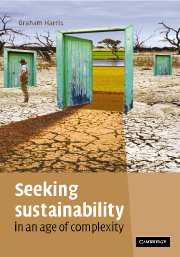Book contents
- Frontmatter
- Contents
- Acknowledgements
- 1 Preamble: the world we are in
- 2 Complexity and complex systems
- 3 New science, new tools, new challenges
- 4 The complexity of ecology
- 5 The generation of complexity
- 6 Micro-interactions and macro-constraints
- 7 A sense of place
- 8 Created landscapes and our changing sense of place
- 9 Catchment form and function
- 10 Catchment loads: ecosystem impacts
- 11 Change detection, monitoring and prediction
- 12 Evidence, uncertainty and risk
- 13 Modified landscapes: biodiversity
- 14 Function in fragmented landscapes
- 15 Environmental flows
- 16 Evidence for global change
- 17 Values and beliefs
- 18 Managing environmental, social and economic systems
- 19 Linking multiple capitals in a changing world
- 20 Community, capacity, collaboration and innovation
- 21 A new environmental paradigm
- 22 Emergent problems and emerging solutions: developing an ‘ecolophysics’?
- 23 Avoiding collapse
- Index
9 - Catchment form and function
Published online by Cambridge University Press: 21 March 2011
- Frontmatter
- Contents
- Acknowledgements
- 1 Preamble: the world we are in
- 2 Complexity and complex systems
- 3 New science, new tools, new challenges
- 4 The complexity of ecology
- 5 The generation of complexity
- 6 Micro-interactions and macro-constraints
- 7 A sense of place
- 8 Created landscapes and our changing sense of place
- 9 Catchment form and function
- 10 Catchment loads: ecosystem impacts
- 11 Change detection, monitoring and prediction
- 12 Evidence, uncertainty and risk
- 13 Modified landscapes: biodiversity
- 14 Function in fragmented landscapes
- 15 Environmental flows
- 16 Evidence for global change
- 17 Values and beliefs
- 18 Managing environmental, social and economic systems
- 19 Linking multiple capitals in a changing world
- 20 Community, capacity, collaboration and innovation
- 21 A new environmental paradigm
- 22 Emergent problems and emerging solutions: developing an ‘ecolophysics’?
- 23 Avoiding collapse
- Index
Summary
The interaction of landscapes and waterscapes: how micro-scale pattern and process can impact on macro-scale properties.
It has been known for some time that land use change has major impacts on catchment behaviour and hydrology, and on the water quality in rivers and estuaries. Natural landscapes, dominated as they are by largely undisturbed ecosystems responding to biophysical constraints, are characterised by high biodiversity, high nutrient and water use efficiencies and what I have called MaxEnt and MaxET solutions arising from SGC or HOT designs. These are the robust ‘neutral domain’ solutions arrived at by long periods of selection through trial and error. In forested systems it may take as long as a few hundred years for the ecosystem to fully develop in terms of the maturity of individual trees and the overall biodiversity; even then there is constant change as patches form and close through disturbance, death and reinvasion. After major disturbance (fire, flood, windthrow, logging, etc.) ecosystems go through a rebuilding sequence of invasion and development. Overall productivity is high in early successional stages but at maturity there is a balance between production and decomposition. This aspect of ecology has been well studied since the early days of ecological investigation. Given time for the development of ecosystems with high biodiversity and maturity (efficient energy and nutrient cycling) then it is clear that production through photosynthesis becomes largely balanced by decomposition and respiration and that internal nutrient recycling is very efficient so that nutrient exports are small.
- Type
- Chapter
- Information
- Seeking Sustainability in an Age of Complexity , pp. 115 - 126Publisher: Cambridge University PressPrint publication year: 2007



